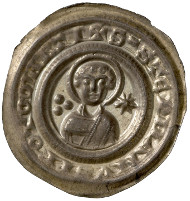courtesy of the MoneyMuseum, Zurich
translated by Teresa Teklic
Why was the human head the motif on coins for centuries, no, for millennia? And why did that change in the last 200 years? Ursula Kampmann is looking for answers to these questions in her book “Menschengesichter” (“Human faces”), from which the texts in this series are taken.
Bishopric of Halberstadt. Gero von Schermbke, Bishop (1160-1177). Pfennig. Head of Saint Stephen. Frontal view of Saint Stephen’s head, to the left, the three stones of his martyrdom, to the right, eight-pointed star. © MoneyMuseum, Zurich.
In 814, Louis the Pious founded the Bishopric of Halberstadt in order to further the conversion of the Saxons. Halberstadt was subordinated to the Bishopric of Mainz and had just become more or less comfortable in this position, when Otto the Great suddenly decided to found his own bishopric in the nearby City of Magdeburg. This meant a serious loss of power and income for both Mainz and Halberstadt. Of course the dioceses didn’t surrender without a fight. The Archbishop of Mainz threatened to resign from his office and get himself killed by the heathens as a missionary, should the Pope consent to such an outrageous violation of law. The aged Bishop of Halberstadt mainly made a mockery of himself by banning the Emperor. It was all to no avail. In 967, the Pope announced the establishment of the new Archdiocese Magdeburg with the new Bishoprics of Merseburg, Zeitz and Meissen. So the Bishop of Halberstadt lost large parts of his estates, which were now used to secure the maintenance of the new bishoprics.
But Otto died soon after, in 973. His son, Otto II, had to admit that the available lands were by no means able to feed and appropriately cater for the needs of so many stately bishoprics. At least one bishopric had to be closed. And thus began the bishops’ fight for the survival of their diocese.
From a medieval point of view, the significance of a church crucially depended on the question, how many precious relics it held. This is why Otto I had brought the dead body of Saint Maurice to Magdeburg and rendered the question of the city’s importance beyond dispute: as the final resting place of such an important saint, it just had to become a clerical centre.
Hans Memling, Saint Stephen, around 1480. Source: Wikicommons.
The Bishop of Halberstadt also attempted to increase his own diocese’s significance with the acquisition of relics. Rumour had it that the Bishop of Metz needed money. And Metz happened to be in possession of valuable relics of Saint Stephen. Halberstadt, on the other hand, had money and so its bishop travelled to Metz to buy these relics. The strategy worked out. When Otto decided which bishopric was to be closed in 981, he chose Merseburg.
To the citizens of Halberstadt it seemed as if Saint Stephen had personally saved them from closing. So it shouldn’t come as a surprise that, when the time came to choose a motif for the coins that the bishopric was legally allowed to mint since 989 that this saint was chosen.
In the next episode of this series, you can learn why the Florentines’ choice of John the Baptist for their coins served as a symbol for democracy.
You can find all episodes in the series here.
A German edition of the book “Menschengesichter” is available in print and as ebook on the site of the Conzett Verlag.





